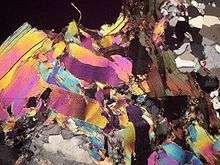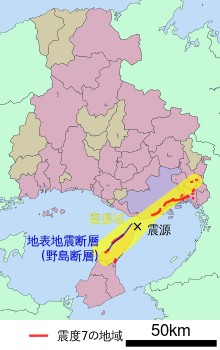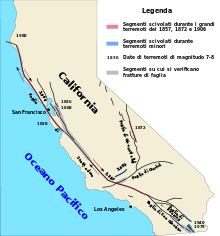Fault gouge
Fault gouge is a tectonite (a rock formed by tectonic forces/brittle deformation) with a very small grain size. Fault gouge has no cohesion and it is normally an unconsolidated rock type, unless cementation took place at a later stage. A fault gouge forms in the same way as fault breccia, the latter also having larger clasts.[1] In comparison to fault breccia, which is another incohesive fault rock, fault gouge has less visible fragments (less than 30% visible fragments regarding fault gouges, and more than 30% regarding fault breccia).[2] Fault gouge is also classified as have particles that are smaller than 1mm in diameter.[3] Therefore, fault gouge is commonly composed of clays which commonly consist of Illite, Montmorillonite, Saponite, Kaolinite, Vermiculite, Quartz, Chlorite, Muscovite, Biotite, and/or Feldspars.[4][5]
Gouge-filled faults can be weak planes in rock masses. If compressive stresses are enough these can cause compressive yielding or eventually rock fracture.[6]
Origin
Fault gouge forms by tectonic movement along a localized zone of brittle deformation (a fault zone) in a rock. The grinding and milling that results when the two sides of the fault zone move along each other results in a material that is made of loose fragments. First a fault breccia will form, but if the grinding continues the rock becomes fault gouge. Larger shearing events at fault zones tend to decrease the particle size of the matrix, in other words, more force correlates to more pulverized and finer material. Foliations can form within the fault gouge parallel to the direction of shear, either suddenly or over the duration of several shearing events.[3]
Depending upon orientation and magnitude of the shearing force, minerals may become metamorphically altered into those such as talc. Frictionally strong and weak minerals such as quartz and talc respectively, can effect the properties of a fault.[7]
Frictional Properties
Friction within a fault is produce by a combination of stresses and fault mineralogical properties. Properties of a fault that pertain to the overal friction include the frictional characteristics of the minerals before they undergo faulting, the characteristics of the matrix material after the initial fault has occurred, and the structural stresses on the fault. Frictional properties of minerals include the shape of the individual particles, and the bond strength of the minerals. Depth and temperature correlate directly to the friction coefficient of fault gouge. Friction coefficients are calculated by dividing shear stress by effective normal stress. Some friction coefficients for minerals are listed below:
| Mineral | Friction Coefficient |
|---|---|
| Montmorillonite[8] | 0.08 - 0.14 |
| Quartz[8] | 0.49 - 0.62 |
| Chrysotile (Serpentine)[9] | 0.7 |
| Illite[10] | 0.6-0.85 |
As can be assumed, introduction of water has a great affect on the frictional properties of fault gouge. Water mostly decreases the frictional values of the gouge, along with many other types of fluids.[11][12] Porosity of the gouge also plays a major role in how much fluid may be absorbed within the matrix. However, if chemicals such as magnesium silicate (Mg3Si4O10), which is the prehydrated version of the mineral talc, come in contact with water, they may become hydrated if conditions are right and the frictional value will decrease. Many other minerals may transition to their hydrous forms when water is introduced into the system.[11] But in some cases, the introduction of water doesn't always reduce the friction within a fault, and it may instead allow a new type of mineral to form.
Temperatures
Because friction is occurring, higher temperatures are generated and can cause mineralogical changes to the fault gouge. This depends on whether the fault is clean fracture or if it is a wide zone. When a fault is generated for the first time, depending on the original mineralogical composition and the temperatures generated by the friction between the two surfaces, the fault gouge may be formed as a separate mineral. But if geothermal gradients are not reached to generate another mineral, the mineralogical composition of the fault gouge will not change.[13] This is of course only with regards to friction and temperature, minerals are constantly changing through a variety of other processes.
Classifications of Fault Gouge
Gouge is usually classified by to characteristics, it may be classified based upon its chemical or mineralogical composition and by its particle size type. Other more specific properties as listed in the previously mentioned sections are not normally part of the naming nomenclature. However, all fault gouge is usually referred to as having a finer particle size than 1mm. Both particle size and mineralogical composition may be analyzed by use of petrology and petrographic thin sections analysis.
Particle Size:
Clay Gouge: Gouge is considered Clay Gouge if the clast size is between 63 - 125 µm.[14][15]
Granular Fault Gouge: Granular fault gouge is described as having particle sizes of 105 - 149 µm.[16]
Classifications based upon chemical or mineralogical composition:

Technically speaking, fault gouge can be composed of almost any mineral or set of minerals depending upon the country rock in the region. Some common fault gouge compositions are listed below.
| Minerals |
|---|
| Illite |
| saponite |
| Serpentine |
| Montmorillonite |
| Kaolinite |
| Vermiculite |
| Quartz |
| Chlorite |
| Muscovite |
| Biotite |
| Feldspars |
| Corresite |
Other:
Simulated Fault Gouge: Simulated fault gouge simply refers to gouge that is being modeled rather than actually being measured in the field. It could also be in done in combination with samples from the field to generate simulation of the fault system.
Notable Fault Gouge
San Andreas Fault Gouge: Consists of two active shear zones: the southwest deforming zone and the central deforming zone. Both are overarchingly composed of serpentinite porphyroclasts and sedimentary rock amongst a Magnesium-rich clay matrix. Saponite, corresite, quartz, and feldspars compose the southwest deforming zone. Saponite, quartz, and calcite compose the central deforming zone.[17]

Nojima Fault Gouge: This fault produced thin oscillating foliations of psudotachylite and fine fault gouge from granite at a depth of 3 km.[17]
See also
- Shale Gouge Ratio (SGR)
- Fault breccia
- Fault (geology)
References
- Twiss, R.J. & Moores, E.M., 2000 (6th edition): Structural Geology, W.H. Freeman & co, ISBN 0-7167-2252-6; p. 55
- Sibson, R. H. (1977). "Fault rocks and fault mechanisms". Journal of the Geological Society of London. 133: 191–213. doi:10.1144/gsjgs.133.3.0191.
- "Processes in Structural Geology and Tectonics v2". psgt.earth.lsa.umich.edu. Retrieved 2020-03-29.
- Wu, Francis T. (1978-07-01). "Mineralogy and physical nature of clay gouge". pure and applied geophysics. 116 (4): 655–689. doi:10.1007/BF00876531. ISSN 1420-9136.
- Ikari, Matt J.; Saffer, Demian M.; Marone, Chris (2009). "Frictional and hydrologic properties of clay-rich fault gouge". Journal of Geophysical Research: Solid Earth. 114 (B5). doi:10.1029/2008JB006089. ISSN 2156-2202.
- Bertuzzi, R., 2015: Tunnel Support Loading Mechanism, UNSW, Sydney, Australia; p. 1
- Wang, Chaoyi; Elsworth, Derek; Fang, Yi (2019). "Ensemble Shear Strength, Stability, and Permeability of Mixed Mineralogy Fault Gouge Recovered From 3D Granular Models". Journal of Geophysical Research: Solid Earth. 124 (1): 425–441. doi:10.1029/2018JB016066. ISSN 2169-9356.
- Logan, John M.; Rauenzahn, Kim Ann (1987-12-15). "Frictional dependence of gouge mixtures of quartz and montmorillonite on velocity, composition and fabric". Tectonophysics. 144 (1): 87–108. doi:10.1016/0040-1951(87)90010-2. ISSN 0040-1951.
- Moore, Diane E.; Lockner, David A.; Tanaka, Hidemi; Iwata, Kengo (2004-05-01). "The Coefficient of Friction of Chrysotile Gouge at Seismogenic Depths". International Geology Review. 46 (5): 385–398. doi:10.2747/0020-6814.46.5.385. ISSN 0020-6814.
- Tembe, Sheryl; Lockner, David A.; Wong, Teng-Fong (2010). "Effect of clay content and mineralogy on frictional sliding behavior of simulated gouges: Binary and ternary mixtures of quartz, illite, and montmorillonite". Journal of Geophysical Research: Solid Earth. 115 (B3). doi:10.1029/2009JB006383. ISSN 2156-2202.
- Morrow, C. A.; Moore, D. E.; Lockner, D. A. (2000). "The effect of mineral bond strength and adsorbed water on fault gouge frictional strength". Geophysical Research Letters. 27 (6): 815–818. doi:10.1029/1999GL008401. ISSN 1944-8007.
- Summers, R.; Byerlee, J. (1977-05-01). "A note on the effect of fault gouge composition on the stability of frictional sliding". International Journal of Rock Mechanics and Mining Sciences & Geomechanics Abstracts. 14 (3): 155–160. doi:10.1016/0148-9062(77)90007-9. ISSN 0148-9062.
- Cardwell, R. K.; Chinn, D. S.; Moore, G. F.; Turcotte, D. L. (1978-03-01). "Frictional heating on a fault zone with finite thickness". Geophysical Journal International. 52 (3): 525–530. doi:10.1111/j.1365-246X.1978.tb04247.x. ISSN 0956-540X.
- Crawford, B. R.; Faulkner, D. R.; Rutter, E. H. (2008). "Strength, porosity, and permeability development during hydrostatic and shear loading of synthetic quartz-clay fault gouge". Journal of Geophysical Research: Solid Earth. 113 (B3). doi:10.1029/2006JB004634. ISSN 2156-2202.
- Vrolijk, Peter; van der Pluijm, Ben A. (1999-08-01). "Clay gouge". Journal of Structural Geology. 21 (8): 1039–1048. doi:10.1016/S0191-8141(99)00103-0. ISSN 0191-8141.
- Scuderi, Marco M.; Carpenter, Brett M.; Marone, Chris (2014). "Physicochemical processes of frictional healing: Effects of water on stick-slip stress drop and friction of granular fault gouge". Journal of Geophysical Research: Solid Earth. 119 (5): 4090–4105. doi:10.1002/2013JB010641. ISSN 2169-9356.
- Lockner, David A.; Morrow, Carolyn; Moore, Diane; Hickman, Stephen (April 2011). "Low strength of deep San Andreas fault gouge from SAFOD core". Nature. 472 (7341): 82–85. doi:10.1038/nature09927. ISSN 1476-4687.
